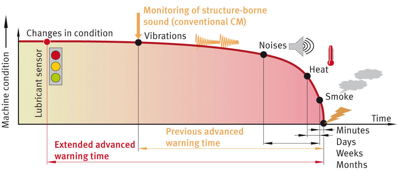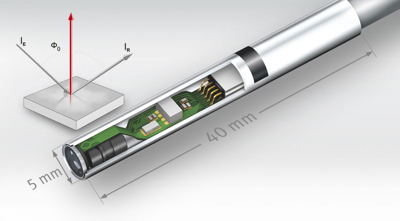Three German organisations have developed a sensing system that monitors the state of grease in rolling bearings as they are running, thus giving advance warning of any problems and allowing the grease to be replaced only when necessary.
The online condition monitoring system – developed by Schaeffler in conjunction with Freudenberg and the lubricants specialist Klüber – is said to be ideal for monitoring critical plant and machinery located in remote or difficult-to-access areas, such as wind turbines and automated assembly lines.

It will allow the replacement of rolling bearing grease to be planned precisely into maintenance schedules. It detects any changes in the condition of the grease long before the bearings suffer any damage, and before vibration-based monitors reveal any potential damage (as shown in the graph above).
In preventive maintenance, the operating life of the grease is critical, especially if it is shorter than the expected life of the bearing. In this case, the bearings are normally re-lubricated halfway through the grease operating life. The disadvantage of this approach is that the grease is replaced without knowing anything about its condition.
For example, it may have been possible to continue using the grease for longer without affecting the performance of the bearing. Conversely, if the bearing has been damaged by the ingress of water or high temperatures, the grease should have been replaced earlier.
Until now, users could get information on the condition of the grease in a bearing only by taking samples and conducting costly, time-consuming laboratory analyses. The new sensor allows grease to be replaced according to the actual operating conditions and not pre-defined time periods. This means that the lubrication becomes demand-based, rather than time-based, cutting the costs of lubricants, replacement parts and maintenance, while having environmental benefits in terms of the amount of lubricant used. Downtime of plant and machinery should also be reduced, and process efficiencies and machine utilisation should improve.
Online monitoring of the condition of the grease enables users to react quickly to any changes that may occur suddenly in the grease. It also allows bearing designs and positioning to be optimised.

The key to the new condition monitoring system is a 5mm-diameter, 40mm-long sensor (shown above), which detects four parameters: the water content of the grease; its cloudiness (opacity); wear (thermal or mechanical); and temperature. The sensor is positioned inside the rolling bearing, immersed in the grease.
The sensor operates by using an optical, near-infrared reflection principle developed in conjunction with Germany’s Fraunhofer Institut for Electronic Nano Systems (ENAS). It is based on a process already used in laboratories to measure the quality of grease, which has now been adapted for online measurements in rolling bearings.
The sensor head is embedded in the lubricant, which it irradiates with infrared light at an angle of 45 degrees. The reflected light is measured perpendicularly to exclude any shadow effects or surface anomalies. Algorithms evaluate the measurements to provide information on the quality of the grease. As well as to displaying the condition of the grease, the system generates an analogue (4–20mA) output.
By setting alarm thresholds (limit values), digital signal outputs can also be generated, indicating whether the grease quality is good or poor. Users can decide at which point – from 100% for as-new grease, to 0% for unusable grease – relubrication or grease replacement need to be carried out.
The sensor is powered by cables which also transmit signals from the sensor to the electronic evaluation system. If required, a wireless version can be supplied.
Schaeffler, Freudenberg and Klüber say they have validated the measurement method for around 95% of greases available on the market. They are developing another version which will integrate the sensor into rolling bearing seals.




